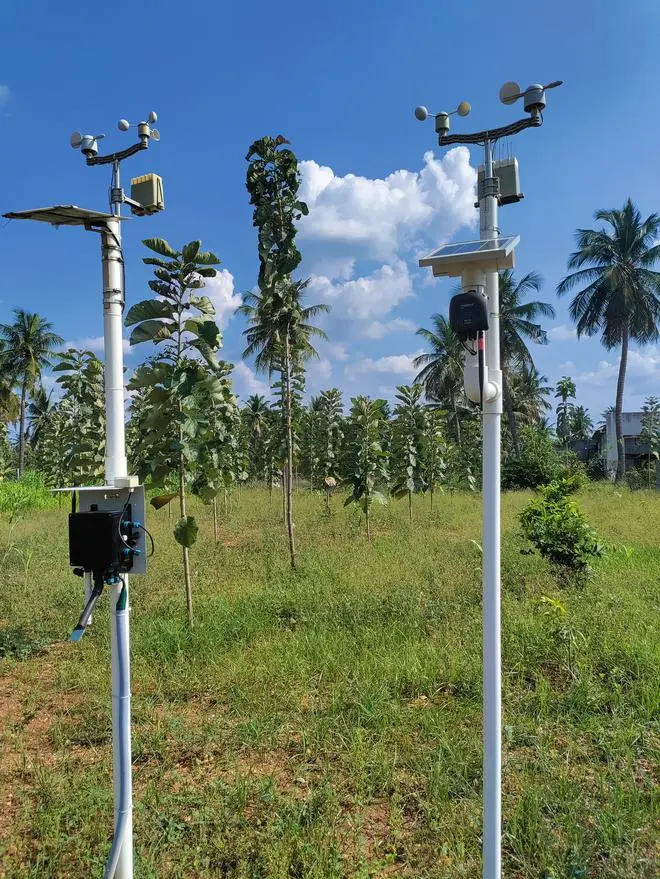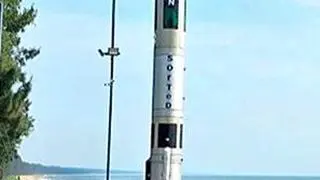The technological leap in agriculture from chemical fertilisers and pesticides to smartphone-based remote operation of irrigation motors happened about a decade ago. Over the last few years, agricultural fields have been awash with more technology.
Today, tech-savvy farmers use drones to identify and root out infected plants before they can damage the entire crop. This solution, of course, is not affordable to all farmers.
But into the wide gap between smartphone-based motor switches and drones and robots, more technology is rushing in. For example, weather stations are being put up on agricultural fields.
Frugal engineering

A weather station at a farm near Erode, Tamil Nadu
In Perundurai, a remote part of Tamil Nadu, a small-sized company called Mobitech Wireless Solutions has been selling products like valves, and wired and wireless valve controllers and sensors. These enable farmers to operate their farm equipment from home, using smartphones. SIM cards inserted in motors or valves do the trick. Using the smartphone’s timer, the farmer can irrigate his fields for fixed periods. Yet another layer of automation is the use of ‘internet of things’ or IoT — the sensors tell the controller when to switch on the irrigation motors and how much water to use. Company officials tell Quantum that business has been growing 40 per cent annually in the last few years, thanks partly to the pandemic and the resultant labour shortage. These IoT-connected sensors typically save 35 per cent in water consumption, the company says.
And now, Mobitech Wireless has launched a weather station — its priciest product at ₹25,000 each. How does the weather station aid the farmer? While other products give the farmer control over irrigation, the knowledge of wind speeds and outside temperature can help optimise water use, explains P Dhanasekaran, General Manager, Mobitech Wireless. For instance, the sensors can gauge soil moisture levels but the weather station could give the controller a word of caution: don’t let out water now, because the wind speeds are high.
An added advantage for farmers, Dhanasekaran said, is that the data proves handy when lodging an insurance claim following crop damage due to bad weather. This saves time and effort for the farmer, who would otherwise be forced to get the data from the district weather station.
Further automation
Beyond sensor-IoT-based agriculture, you have ‘deep learning’ (a subset of machine learning) and fuzzy logic lending a hand in crop management. In a recent scientific paper published in Smart Agriculture Technology journal, researchers Anis Ahmed, Dharmendra Saraswat and Aly El Gamal of Purdue University note that “the use of deep learning techniques for plant disease diagnosis provides multiple advantages, including separating disease symptoms, identifying multiple diseases and estimating disease severity”. They point out that deep learning techniques have been used on images acquired from multispectral and hyperspectral sensors to identify the disease-affected regions in a field; thermal sensors and fluorescent sensors have also been used.
Plant disease identification is necessary for precision agriculture and plant phenotyping. Both these areas are data-, information-, and technology-intensive. But researchers today have access to data, mainly from different collection platforms, handheld sensors and drones. Deep learning has become a preferred approach for disease identification due to increased computational power, storage capacities, and availability of large datasets, the authors say.
Another paper, authored by Kalavathi Devi Thangavel, et al, of Kongu Engineering College, Perundurai, Erode, focuses on the specific design of intelligent microclimate controllers for greenhouses.
Prof Thangavel told Quantum that their work was based on computer simulations of data obtained from a local greenhouse. The simulation took temperature, humidity and soil moisture as inputs and regulated the operations of the heater, pump and humidifier. This, of course, remains to be tested in a real greenhouse, but it is believed that high crop yields are possible.
All these indicate that the world is just beginning to scratch the surface of emerging technologies for agriculture.











Comments
Comments have to be in English, and in full sentences. They cannot be abusive or personal. Please abide by our community guidelines for posting your comments.
We have migrated to a new commenting platform. If you are already a registered user of TheHindu Businessline and logged in, you may continue to engage with our articles. If you do not have an account please register and login to post comments. Users can access their older comments by logging into their accounts on Vuukle.